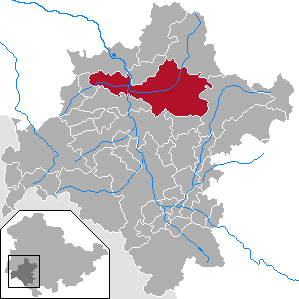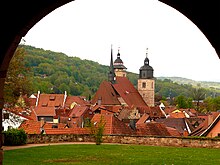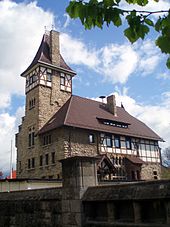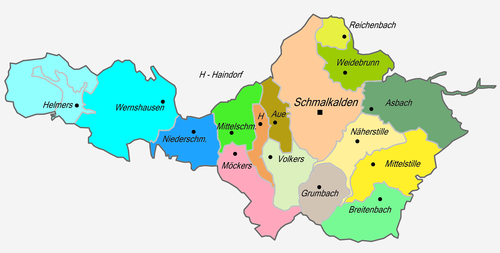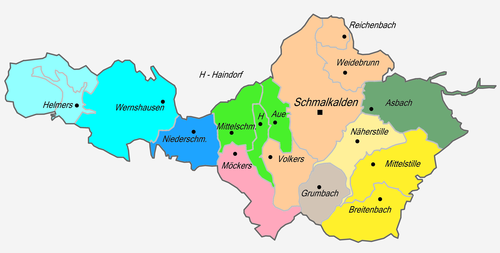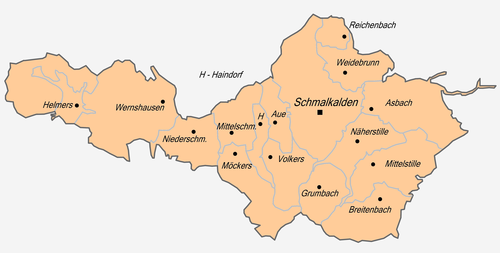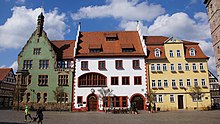Schmalkalden
| coat of arms | Germany map | |
|---|---|---|

|
Coordinates: 50 ° 43 ' N , 10 ° 27' E |
|
| Basic data | ||
| State : | Thuringia | |
| County : | Schmalkalden-Meiningen | |
| Height : | 295 m above sea level NHN | |
| Area : | 105.38 km 2 | |
| Residents: | 19,647 (Dec. 31, 2019) | |
| Population density : | 186 inhabitants per km 2 | |
| Postal code : | 98574 | |
| Primaries : | 03683, 036848 (Wernshausen) | |
| License plate : | SM, MGN | |
| Community key : | 16 0 66 063 | |
| LOCODE : | DE SKL | |
| City structure: | 16 districts | |
City administration address : |
Altmarkt 1 98574 Schmalkalden |
|
| Website : | ||
| Mayor : | Thomas Kaminski (independent) | |
| Location of the city of Schmalkalden in the district of Schmalkalden-Meiningen | ||
Schmalkalden is a city in the southwest of the Free State of Thuringia . The half-timbered and university town, which was politically and administratively part of Hesse for a long time, is a medium-sized center in the district of Schmalkalden-Meiningen and is located southwest of the Thuringian Forest .
geography
The city is located on the southwest slope of the Thuringian Forest at the confluence of the Schmalkalde and the Stille as well as the Schmalkalde and the Werra .
Neighboring communities are Breitungen / Werra , Fambach , Floh-Seligenthal , Steinbach-Hallenberg , Christes , Metzels , Wasungen , Schwallungen and Rosa .
history
Schmalkalden appeared for the first time in the year 874 as "villa Smalcalta" in a document next to Wasungen and Schwallungen as one of those places in Grabfeldgau that the noble Kunihilt, belonging to the Franconian nobility, transferred to the Fulda monastery .
During the dispute over the royal throne between the Staufer Philip of Swabia and the Guelph Otto IV , the place was destroyed in 1203. Elisabeth of Thuringia said goodbye to her husband, Landgrave Ludwig IV of Thuringia , in Schmalkalden in 1227 . Ludwig moved to Italy via Hesse, Franconia, Swabia and Bavaria, where he met the crusade army of Emperor Friedrich. On September 12, shortly after embarking in Otranto , he died of an infection. A year later, to celebrate the victory, Count Poppos XIII. von Henneberg († 1245) about the Würzburg Bishop Hermann I von Lobdeburg in Metzels the establishment of the Schmalkalder Nikolausmarkt. In 1247 Schmalkalden came to the Counts of Henneberg after the death of Heinrich Raspe , the last Ludowingian Landgrave of Thuringia, and in the course of the Thuringian-Hessian War of Succession that followed .
Becoming a city
Schmalkalden was first mentioned as a town in a document in 1250 ( cives ) and in 1335 received town charter from Gelnhausen . The city seal shows in the picture: "above a wall with a gate between two towers a hen on a mountain". It unites the characteristics of the city architecture (city wall, towers, city gate) with the stately coat of arms of the hen, which emerges due to its size. As early as 1272, this seal was used as evidence of the city's self-government and later served as a template for the design of the city's coat of arms.
In 1320 the collegiate monastery of St. Egidii and Erhardi and the Augustinian monastery in Schmalkalden were founded. Landgrave Henry II. Of Hesse confirmed in 1360 in a letter that he and Elisabeth von Henneberg-Schleusingen, the widow of Count Johann I von Henneberg-Schleusingen , city and office Schmalkalden and Herrenbreitungen "with accessories" by Albrecht von Nürnberg bought and have concluded a mutual inheritance contract with her for this purpose. The purchase price for the two places was 43,000 gold guilders. This established the Henneberg-Hessian rule over Schmalkalden. The town of Schmalkalden was divided by the condominium that was now in place . To the east and south of the Schmalkaldekunstgraben was the Henneberg half, beyond the ditch the Hessian side. Both had their own administration in the city with the Hessenhof and the Henneberger Hof. The power and position struggles that broke out immediately had a negative effect on the rule.
Jewish traces were found with the excavation of the mikveh from the 14th century.
The town hall was built in 1419. In 1437 the construction of the town church began.
16th to 19th century
As the exclave and center of the Schmalkalden rule , half of the town of Schmalkalden belonged to Hesse from 1360, and from 1584 completely, for about 600 years .
Schmalkalden is known in particular through the 1531 entrainment of Count Philipp the Magnanimous of Hesse during the convention in Schmalkalden closed Smalcald collar in which the Protestant to states- merged after Kaiser Karl V. on the Augsburg Diet 1530 Augsburg Confession , d. H. the Protestant Creed. During the time of the Schmalkalden Confederation between 1530 and 1547, seven of the total of 26 federal meetings took place in Schmalkalden. In 1546/47 the clashes between the Bund and the Kaiser culminated in the Schmalkaldic War .
With the death of the Prince Count Georg Ernst of Henneberg in 1583, the Henneberg lineage died out. With this came the case of an inheritance contract, which ended the Henneberg-Hessian dual rule that had existed since 1360. From 1584 the Hessian Landgrave Wilhelm IV ruled alone in the city and the rule of Schmalkalden . From 1585 to 1590 Wilhelm IV had the Wilhelmsburg named after him built.
During the time of the witch hunt, the accused Anna Bühn died in prison in 1605; the proceedings against Osanna Abe 1657–1659 ended with an expulsion from the country.
In 1611 Jewish families were allowed to settle in Schmalkalden again. A Jewish cemetery was laid out around 1611, and a synagogue was built in 1622 .
For several centuries, Schmalkalden deputies sat in the state parliaments of the Landgraviate of Hesse-Kassel (until 1803), the Electorate of Hesse (1831 to 1866) and in the provincial parliament of the Province of Hesse-Nassau (1886 to 1933).
20th century until today
With the dissolution of the province of Hessen-Nassau by the Nazi government on July 1, 1944, the city with the entire district of Schmalkalden was incorporated into the administrative district of Erfurt , which was also subordinated to the administration of the Reich governor for Thuringia in Weimar and was part of it in 1945 of the state of Thuringia.
At the beginning of the National Socialist era , people were persecuted for political, racist and religious reasons. Those who died in the process included the founder and editor of the social democratic newspaper Die Volksstimme , Ludwig Pappenheim , who was shot in the Börgermoor concentration camp . After the end of the war, the town of Kleinschmalkalden gave itself the name Pappenheim , but dropped it again after 1990, as did the former school in Walperloh, which had been named after him in 1987.
The co-founder of the KJVD Hermann Danz had contacts with the resistance group Neubauer-Poser in Jena , but was discovered, sentenced to death by the People's Court and executed in 1945 in Brandenburg-Görden . The school named after him on Renthofstrasse lost its name in 1990, and a plaque on his house at Klinge 26 was also removed. In 2013 a memorial plaque was attached to the former Hermann Danz School. A memorial stone in the Pfaffenbach park commemorates him. In the Eichelbach cemetery , memorial stones commemorate both resistance fighters.
During the November pogroms in 1938 , the synagogue in Judengasse was desecrated, cult objects were burned in public and the building was blown up. From 1988 to 2010 a memorial plaque in Judengasse 35 commemorated this event. The Jewish families and the families of the Sinti emigrated or were deported to the extermination camps in the East. The hereditary health courts ordered the compulsory sterilization of 272 people. 113 people from the Christian nursing home in Schmalkalden-Aue were taken to Action T4 to be killed as part of the euthanasia program . During the Second World War , 1,755 prisoners of war , as well as women and men from the countries occupied by Germany, had to do forced labor : in the cemetery, in the city construction office, in the gas works, in the hospital, in the slaughterhouse, in road construction, in the forestry office, in the drill mill , at the company Gebrüder Heller , at HA Erbe and at Karl Braun . A total of 74 women, children and men were victims of forced labor and buried in the Im Eichelbach cemetery.
→ Main article: Air raids on Schmalkalden
Schmalkalden was twice the target of aerial attacks by the 8th Air Force heavy strategic bombers during World War II . On July 20, 1944, about 30 (planned 80) B-24 "Liberator" and on February 6, 1945 32 "Flying Fortresses" called B-17s with 75 tons of bombs attacked the city. There were a total of 88 dead, many injured and severe damage to homes and industrial facilities. On February 6, 1945, the existing buildings in the old town were severely affected: especially the buildings in Haindorfgasse, mainly two- and three-story, mostly plastered half-timbered houses from the 16th to 18th centuries, as well as parts of the market development. Part of the intended bomb load fell outside the city, especially in the Queste, but also in other Thuringian places. If all the bombers had reached their destination Schmalkalden, the city would have fallen to rubble.
On April 3, 1945, US troops occupied the city. Mention should be made at this point of the courageous commitment of the chief physician of the Schmalkalder Klinik Friedrich Jahn , who defied the instructions of the German Wehrmacht and thus ensured that Schmalkalden was handed over to the Americans without a fight. In early July 1945 the American troops surrendered the city to the Red Army . Like the entire state of Thuringia, Schmalkalden was added to the Soviet Zone in accordance with the Allied Agreement and was part of the workers 'and farmers' state when the GDR state was founded in 1949. As a reminder of the excesses of Stalinism and in memory of its victims in the city, a memorial plaque was attached to the former district court building.
In 1947 a memorial for forced labor victims from the Soviet Union was established, which was restored in 1999.
The local state technical college for small iron and metal goods industry was upgraded to an engineering school for mechanical engineering in 1949 . In 1950 the Schmalkalden district was dissolved. Just two years later, as part of the GDR municipal reform with changed borders, it was newly created and assigned to the new Suhl district. The pedagogical college for kindergarten teachers was founded in 1951.
As part of the industrialization aimed at by the state, the city, which was still heavily characterized by handicraft businesses and small companies with state participation, was developed into the main location of VEB United tool and cutlery factories through a merger of the most important manufacturers . The large company, which continued to be distributed over numerous parts of the city and the surrounding area, became known under the acronym WEBEFA. In 1976 he became the lead company of the Schmalkalden tool combination , the most important manufacturer of tools and small electrical appliances in the GDR, which was of great importance for foreign trade. The parent company was in Schmalkalden and had a cooperation agreement with the engineering school for mechanical engineering. With the successful participation of the southern Thuringian winter sports enthusiasts in the Olympics and world championships, sports equipment manufacturing in Schmalkalden was promoted. VEB Kombinat Sportgeräte Germina with headquarters in Schmalkalden was founded as the most important manufacturer in 1976 . The holding of the workers' festival in 1978 was considered a cultural highlight. The preparation of the event resulted in brisk construction and renovation work (usually facade renovations) in the center of the historic old town and the castle, which was continued in other parts of the city center from 1985.
After 1945, the Schmalkaldens area was still part of the Evangelical Church of Kurhessen and Waldeck . After the GDR authorities prevented the participation of synodals from Schmalkalden in the regional synods of the Evangelical Church of Kurhessen and Waldeck from 1968 onwards, a contract dated April 28, 1970 (supplemented by a secret additional protocol by Bishops Moritz Mitzenheim and Erich Vellmer on the Option of reorganization after the hoped-for German reunification) the Schmalkalden deanery was incorporated into the Evangelical Lutheran Church in Thuringia .
With the German reunification in 1990, with a view to the common history, one expected the rapid accession of the district area to the federal state of Hesse , which soon turned out to be an illusion. Only in the area of the Protestant Church have the parishes around Schmalkalden belong again to the Evangelical Church of Kurhessen-Waldeck since 1991.
In the newly founded Free State of Thuringia, Schmalkalden initially retained the status and tasks of a district town. With the municipal and territorial reform of 1994, the district of Schmalkalden was united with the district of Meiningen and Schmalkalden lost its district town status, but retained a branch of the district office. It was also planned to rededicate the engineering school for mechanical engineering into a technical college. The University of Applied Sciences Schmalkalden was founded in 1991, and in 2004 the city was given the official title of University City . The urban area has grown significantly since the 1950s through the incorporation of mostly small surrounding communities. With the incorporation of the village of Wernshausen, the urban area of Schmalkalden expanded for the first time to an area west of the Werra.
On the night of November 1, 2010, a sinkhole caused a crater [ Pos ] about 20 meters deep and 30 to 40 meters in diameter. The geological state service confirmed that it was a natural cavity collapse. In order to assess the risks, the crater was inspected through aerial photographs. Due to the greater flexibility of came instead helicopter a drone type md4-1000 used. The MAV was used to take aerial photos from a height of up to 150 meters and a radius of 500 meters.
City structure and incorporations
The city has the following districts:
- Aue
- Asbach
- Breitenbach
- Grumbach
- Haindorf
- Helmers
- Mittelschmalkalden
- Medium quiet
- Möckers
- Closer silence
- Niedermalkalden
- Reichenbach
- Springstille (since July 6, 2018)
- Volkers
- Weidebrunn
- Wernshausen
Population development
Development of the population (from 1960 December 31) :
|
1830 to 1960
|
1981 to 2001
|
2002 to 2011
|
from 2012
|
- Data source from 1994: Thuringian State Office for Statistics
(1) October 29th
(2) August 31st
politics
City council
Since the local elections on May 25, 2014, the city council has been composed as follows , with a total of 24 seats :
| SPD / Greens | 11 seats |
| CDU | 6 seats |
| The left | 4 seats |
| Citizens' Initiative (BI) / Free Voters | 2 seats |
| FDP | 1 seat |
coat of arms
Description of the coat of arms
Blazon: In red a two-towered silver castle with a blue roof and four golden tower knobs, in the open gate a split shield, in the front in gold a black hen with a red comb and red rag on a green three-mountain, behind in blue nine times of silver and red divided, golden crowned lion. | Description = The content of the shield (hen and lion) goes back to the historical development of the city between 1360 and 1583. During this time, the city of Schmalkalden lived in a condominium (dual power) between the Landgraviate of Hesse-Kassel and the princes of Henneberg . When Count Georg Ernst von Henneberg died childless in 1583, the Henneberg possessions fell to Landgrave Wilhelm IV of Hessen-Kassel.
Town twinning
Schmalkalden maintains town twinning with Fontaine in France and Recklinghausen .
There are also city friendships with Tábor ( Czech Republic ), Alpignano ( Italy ) and the German cities of Dinkelsbühl , Remscheid and Waiblingen (since 1990). There are also friendly relationships between the Schmalkalder grammar school and the German-speaking grammar school in Montana ( Bulgaria ).
Culture and sights
→ See also: List of cultural monuments in Schmalkalden
Buildings, monuments, places of remembrance
- Cityscape worth seeing, 90% of the late medieval half-timbered houses have been preserved.
- City Church of St. Georg (built 1437–1509)
- Wilhelmsburg Castle (built 1585–1590)
- Totenhofskirche (built 1760)
- Luther House (built 1530)
- Hessenhof on the west side of Neumarkt (with Iwein illustration cycle 13th century, oldest secular wall painting in Germany)
- House in Weidebrunner Gasse 13 (built 1369–1370); the oldest half-timbered house in Schmalkalden shows a mixture of post and floor construction . It was renovated in 2013 with the help of the German Foundation for Monument Protection . It originally had a hall, a living room and a storage floor and was adapted to the needs of its residents in later times, but was never completely rebuilt. The half-timbered structure from the construction period has been preserved, as have medieval paintings and an extinguishing hearth from the 14th century when a forge was operated there. Since the reopening, handicrafts have been offered on the ground floor, above which the Friends' Association and the Association for Schmalkaldic History and Regional Studies have moved into offices. There are also areas for exhibitions.
- Former stables (built after 1618) in the street "Hope" No. 30. Marriage coat of arms of Moritz Landgraf zu Hessen-Kassel (1572–1632) and his second wife, Mrs. Juliana Landgräfin zu Hessen-Kassel, née Countess von Nassau-Siegen ( 1587-1643). Later district court building . Now Schmalkalden land registry office. On the building (gable end of Kothersgasse) there is a memorial plaque with the inscription “In 1945 the notorious dungeon of the Soviet NKVD was here . In memory of our innocently murdered comrades. The victims of Stalinism Thuringia ”.
- Holy grave dwelling, Pfaffengasse 26. Bower with stepped gables, Romanesque structure in the core, upper floors from the 15th century, on the right extension from the 16th century, coat of arms stone for Wilhelm VI dated to 1515. Count and Lord of Henneberg-Schleusingen (1478–1559).
- Neue Hütte Technical Museum (historical blast furnace facility)
State Garden Show 2015
From April 25 to October 4, 2015, the Thuringian State Horticultural Show Schmalkalden 2015 took place in the city .
Regular events
- Schmalkalder Hirschessen (city festival), last weekend in August
- Summer film nights (open air cinema)
- "Schmalkalder Herrscheklasmarkt" - historical Christmas market in Schmalkalden
Dialect rehearsal
- Bas me üwer onser all Staadt Schmakalle moss wess
- Mi Schmakalle es all Staadt, de schonn ville thundered Joahr of`n Buckel hatt. He had got a lot of famous Lüt, he didn't forget woar`n beshüt. Martin Luther, who overthrew the Bible, belongs there, awer au si friend, Philipp Melanchton was a well-known Moa. Ör Önnerkunft had taken place in den Lutherhuus of`n Lutherplatz and in the current Roseapothäke in Steigass. The Welhelms Karl, who wrote many compositions, was a detractor who made his hometown famous for the composition of “Wacht am Rhein”. Ofn Schlooß honn ville Researched, Count and Prinze gelaat, awe villas in our pretty town were pleased. ... (Hans Schwarz)
Economy and Infrastructure
economy
The economic basis for the development of the area around Schmalkalden was the mining and processing of brown and red iron stone ( iron ore ). The ore mining was first mentioned in 1340.
Due to the proximity of the rich wood stock in the Thuringian Forest, it was possible to smelt the ore in the vicinity of the mining using wind furnaces. Over time, these were replaced by the Niederen and Hohen Blauofen.
In 1397, so-called "Schmalkalder articles", a name for steel goods manufactured in the city, were represented at the Frankfurt fair. Around the year 1554 there were 225 blacksmith shops. The manufacture of iron and steel goods then extended to, among other things, awls and drills, knives and scissors, harrows and spoons, horseshoes, tongs and skewers. At the turn of the 20th century, the change from handicraft to industrial production began. Today the economic profile of the city of Schmalkalden consists of companies in the tool industry, special machine and tool construction, the food and beverage industry as well as woodworking and the construction industry. Well-known companies in the GDR were the Schmalkalden tool combination and the VEB Sports Equipment Combination Germina, and Thuringian Waldquell (mineral water and Vita-Cola producer) is still today . During the GDR era, the products of the VEB nougat and marzipan factory were Schmalkalden / Thür. known throughout the GDR. The nougat manufacturer Viba Sweets GmbH opened the Viba Nougat World for visitors in 2012 .
traffic
Since the incorporation of Wernshausen in December 2008, the federal road 19 has run through the area of the city of Schmalkalden. The next federal motorway is the A 71 . The distance to the Meiningen -Nord junction is around 24 kilometers and the Suhl / Zella-Mehlis and Oberhof junctions are around 26 kilometers. In order to make the city more attractive for economic investments, it was agreed to extend the federal highway 62 ( Bad Hersfeld - Barchfeld ) to the A 71 in the Suhl / Zella-Mehlis area. In this context, the existing road is to be expanded, as the traffic from the southern Thuringian economic center Suhl / Zella-Mehlis in the direction of East Hesse (Bad Hersfeld, Kassel ) has increased and the previous roads can no longer cope with it. A bypass for Schmalkalden is already under construction. Schmalkalden is on the German half-timbered road .
With the railway line Wernshausen-Zella-Mehlis (-Suhl) Schmalkalden is connected to the railway network since 1874th This route is used by the Süd-Thüringen-Bahn . The main station , the Schmalkalden University of Applied Sciences (formerly Stillertor), Auehütte , Mittelschmalkalden, Niederschmalkalden and Wernshausen stops are located in the Schmalkalder area . There you have the possibility to change to trains of the Werrabahn . Meininger Busbetriebs GmbH is active in city and regional bus transport .
education
In 1902 the "Royal School for Small Iron and Steel Goods Industry Schmalkalden" was founded, which in 1918 received the status of a state technical school. In 1950 the engineering school for mechanical engineering emerged from it, which was an important engineering school in the education system of the GDR . The Schmalkalden University of Applied Sciences, founded in 1991, follows on from these traditions, but is not a legal successor to the earlier schools. Since 2004 the city has been entitled to use the designation "University City".
The Schmalkalden vocational training center offers further vocational training opportunities. Vocational school students from the vocational training center took part in the construction of several objects in the National Monument Sculpture Park German Unity .
Schmalkalden has three primary schools (in Schmalkalden and Asbach), a regular school (Staatliche Regelschule Schmalkalden) and a grammar school ( Philipp-Melanchthon-Gymnasium Schmalkalden ) as well as a vocational training center BBZ (vocational school, vocational school, technical college and vocational grammar school). The state regional support center "Ludwig Bechstein" Schmalkalden promotes and supports the personality of disabled children and young people in school. Other educational institutions are the Pestalozzi School Schmalkalden, the Thuringia Institute for the Blind and the Schmalkalden Adult Education Center .
The Schmalkalden Music Association and the Music School offer early musical education and solid general education.
Medical institutions
The Elisabeth Klinikum Schmalkalden , a basic and standard care hospital, opened in 1945 , has around 317 employees (as of 2014) and, with its medical departments, is of great importance for the Schmalkalden region. Together with the adjacent MVZ and dialysis center, it offers a small regional health center. For acute medical cases, the DRK Kreisverband Schmalkalden eV provides an ambulance in the city center.
Personalities
With Kati Wilhelm , Sven Fischer and Frank Luck , three of the total of nine German Biathlon World Cup winners of the post-reunification period come from Schmalkalden.
sons and daughters of the town
- Johannes Matthaeus (1526–1588), Protestant theologian
- Johannes Malsius (around 1545 - 1594), Protestant clergyman, court preacher in Wolfenbüttel
- Vincentius Schmuck (1565–1628), Evangelical Lutheran theologian and hymn poet
- Balthasar Simon (1591–1635), doctor and professor at the University of Tübingen
- Johannes Bornschürer (1625–1677), Protestant theologian
- Christoph Cellarius (1638–1707), Halle grammar school director and history professor
- Johann Conrad Geisthirt (1672–1737), historian, author of Historia Schmalcaldia
- Jesaias Friedrich Weissenborn (1673–1750), Lutheran theologian
- Johann Simonis (1698–1768), Protestant theologian and orientalist
- Christian von Massenbach (1758–1827), Prussian colonel and writer
- Salomon Friedrich Merkel (1760–1823), lawyer in Kassel
- Karl Friedrich Vollgraff (1794–1863), lawyer and early sociologist
- Carl Wilhelm (1815–1873), choirmaster and composer of Die Wacht am Rhein, among others
- Hans Iber (1886–1946), Reich judge
- Friedrich Jahn (1888–1984), doctor
- Curt Jahn (1892–1966), German officer, most recently general of the artillery in World War II
- Kurt Schlesinger (1902–1964) mechanic of Jewish descent and Nazi collaborator in the Westerbork transit camp
- Eberhard Weis (1925–2013), historian
- Jörg Peter (* 1931), civil engineer
- Heinz Roth (* 1931), MfS officer
- Werner Lesser (1932-2005), ski jumper
- Karl-Heinrich Bieritz (1936–2011), Protestant theologian
- Wolfgang Wicht (* 1937), English studies professor for the history of English literature at the PH Potsdam
- Dietrich Papsch (* 1938), environmental activist and book author
- Angela Steinmüller (* 1941), mathematician and writer
- Peter Eck (1944–1968), fatality on the inner-German border
- Elke Kast (1946–1993), television announcer
- Wieland Giebel (* 1950), author, editor and publisher
- Christa Moog (* 1952), writer
- Ulrike Apel-Haefs (1952–2009), politician (SPD)
- Manfred G. Schmidt (* 1952), epigraphist
- Heiko Salzwedel (* 1957), cycling trainer
- Petra Sonntag (* 1957), former judoka and honorary citizen of Schmalkalden
- Kirsten Tackmann (* 1960), politician (Left Party)
- Peter Kunzmann (* 1965), soccer player
- Frank Luck (* 1967), former biathlete
- Susanne Nickel (1967–2016), book artist
- Sven Fischer (* 1971), former biathlete and honorary citizen of Schmalkalden
- André Knapp (* 1973), local politician and Lord Mayor of Suhl
- Steffi Jacob (* 1975), skeleton pilot
- Kati Wilhelm (* 1976), former biathlete
- Alexander Wolf (* 1978), former biathlete
- Kati Klinzing (* 1982), skeleton pilot
- Stefanie Szczurek (* 1986), bobsledder
- Juliane Döll (* 1986), former biathlete
- Vanessa Voigt (* 1997), biathlete
Other personalities
- Caspar Aquila (1488–1560), reformer, dean of Schmalkalden
- Samuel Fischer (1547–1600), professor, pastor and superintendent, lived temporarily in Schmalkalden
- Johann Nikolaus Tischer (1707–1774), organist and composer, lived in Schmalkalden
- Johann Friedrich Doles (1715–1797), composer, went to school in Schmalkalden
- Johann Jakob von Pistor (1739–1814), Russian lieutenant general and the family ran a rifle factory in Schmalkalden
- Johann Gottfried Vierling (1750–1813), organist and composer, lived in Schmalkalden
- Hans Adolph Friedrich von Eschstruth (1756–1792), lawyer and composer, went to school in Schmalkalden
- Friedrich Haeffner (1759–1833), composer, court music director in Stockholm, then Director Musices University of Uppsala, completed his training as an organist in Schmalkalden
- Andreas Wiß (1788–1816), poet, attended the local lyceum and died in Schmalkalden
- Friedrich von Basse (1893–1972), politician (SPD), district administrator in Schmalkalden
- Walter Kolb (1902–1956), politician (SPD), elected district administrator of Schmalkalden in 1932
- Hermann Danz (1906–1945), politician (KPD) and resistance fighter against National Socialism, grew up in Schmalkalden
- Arthur Rudolph (1906–1996), rocket engineer, studied between 1921 and 1924 in Schmalkalden
- Dieter Wittich (1930–2011), philosopher, grew up in Schmalkalden
- Alois Bräutigam (1916–2007), City Councilor (SED) 1946–1949
- Jens Goebel (* 1952), politician (CDU), former Thuringian minister of education, 1991 to 1999 professor at the Schmalkalden University of Applied Sciences
- Katrin Apel (* 1973), biathlete, completed her professional training in Schmalkalden
- Monique Riekewald (* 1978), skeleton pilot, studies in Schmalkalden
- Ludwig Pappenheim (1887–1934), politician (USPD, SPD), 1919–1933 member of the state parliament, murdered in 1934 in the Neusustrum concentration camp
literature
- Between Ruhla, Bad Liebenstein and Schmalkalden (= values of our homeland . Volume 48). 1st edition. Akademie Verlag, Berlin 1989.
- Harry Gerlach : Schmalkalden (= Thuringian cities. 15). Perthes, Gotha 1994, ISBN 3-623-00976-8 .
- Peter Handy, Karl-Heinz Schmöger: Princes, Estates, Reformers. Schmalkalden and the Schmalkaldic Bund. Perthes, Gotha 2002, ISBN 3-623-00746-3 .
- Helmut Kirchner: Through the centuries of the city and the district of Herrschaft Schmalkalden. History and stories. Kirchner, Schmalkalden 1992.
- Norbert Krah: The technical and engineering school Schmalkalden. A historical outline. Stadt-Bild-Verlag, Leipzig 2002, ISBN 3-934572-51-0 .
- Norbert Krah: The iron trade and the metalworking industry in Schmalkalden. From the beginning to the present. Resch, Meiningen 2006, ISBN 3-9810525-7-9 .
- Hans Lohse: Schmalkalder mining, metallurgy and iron craft. Schmalkalden 1955
- City of Schmalkalden - “Festschrift” working group (Ed.): 1125 years of Schmalkalden. Festschrift. City of Schmalkalden - “Festschrift” working group, Schmalkalden 1999, ISBN 3-00-004395-0 .
- Johann G. Wagner: History of the city and rule of Schmalkalden, together with a brief overview of the history of the former lordship of Henneberg. Elwert'scher Verlag, Marburg et al. 1849, ( digitized ).
- Paul Weber: The Wilhelmsburg over Schmalkalden. Edited by Michael Eckardt. Elch-Verlag, Bad Liebenstein 2005, ISBN 3-933566-30-4 .
- Przemyslaw Paul Zalewski: Building history of a craft town in the Hessian-Franconian-Thuringian border region: urban structure and building structures in the town of Schmalkalden from the 13th to the 18th century (= workbooks of the Thuringian State Office for Monument Preservation. NF 12). Reinhold, Altenburg 2003, ISBN 3-910166-90-3 .
See also
Web links
Individual evidence
- ^ Population of the municipalities from the Thuringian State Office for Statistics ( help on this ).
- ↑ Volker Wahl : Origin and Development of the City of Schmalkalden in the Middle Ages. In: Head of the Museum Schloss Wilhelmsburg Schmalkalden (ed.): Contributions to the history of Schmalkalden. Museum Schloss Wilhelmsburg, Schmalkalden 1974, pp. 13–34, here p. 20.
- ^ Seals of three Henneberg cities. In: Thomas Wurzel (Hrsg.): Who protects and receives ... Hidden treasures from Thuringian archives. Sparkassen-Kulturstiftung Hessen-Thüringen, Frankfurt am Main 1999, p. 35.
- ↑ Norbert Krah: The iron trade and the metal processing industry in Schmalkalden. Resch, Meiningen 2006.
- ↑ Kai Lehmann : Innocent. Witch hunt south of the Thuringian Forest. Over 500 researched cases from the 16th and 17th centuries. Wehry-Verlag, Untermaßfeld 2012, ISBN 978-3-9813902-8-5 , p. 314 f.
- ↑ Ronald Füssel: The witch persecutions in the Thuringian area (= publications of the working group for historical witchcraft and crime research in Northern Germany. Volume 2). DOBU-Verlag, Hamburg 2003, ISBN 3-934632-03-3 , p. 244 f. (At the same time: Marburg, University, dissertation, 2000).
- ↑ 100 years of boys' school: Memorial plaque for Hermann Danz unveiled. Wochenspiegel Thuringia from June 5, 2013.
- ^ Roger A. Freeman, Alan Crouchman, Vic Maslen: Mighty Eighth War Diary. Jane's, London et al. 1981, ISBN 0-7106-0038-0 , pp. 300, 434.
- ↑ Rudolf Zießler: Schmalkalden. In: Götz Eckardt (Ed.): Fates of German architectural monuments in the Second World War. A documentation of the damage and total losses in the area of the German Democratic Republic. Volume 2: Districts Halle, Leipzig, Dresden, Karl-Marx-Stadt, Erfurt, Gera, Suhl. Henschel-Verlag, Berlin 1978, ISBN 3-406-03913-8 , pp. 528-529.
- ↑ Thuringian Association of the Persecuted of the Nazi Regime - Association of Antifascists and Study Group of German Resistance 1933–1945 (Ed.): Local history guide to sites of resistance and persecution 1933–1945. Volume 8: Thuringia. VAS - Verlag für Akademische Schriften, Frankfurt am Main 2003, ISBN 3-88864-343-0 , p. 256 ff.
- ↑ Development of traditional industrial areas in southern Thuringia until 1990. In: Norbert Moczarski et al.: Thuringian State Archive Meiningen, Department Regional Economic Archive South Thuringia in Suhl. A brief inventory overview. Thüringisches Staatsarchiv, Suhl 1994, pp. 16–24.
- ↑ Volker Knöppel: History of the Evangelical Church of Kurhessen-Waldeck 1945 to 2000. In: Rainer Hering, Jochen Christoph Kaiser (eds.): Kurhessen and Waldeck in the 20th century (= contributions to church history. Vol. 2). Verlag Evangelischer Medienverband, Kassel 2012, ISBN 978-3-89477-880-4 , pp. 385-530, here pp. 519-522.
- ^ Sinkfalls in Thuringia ( Memento from November 4, 2010 in the Internet Archive ) Background report of the MDR
- ↑ Crater in Thuringia on T-Online.de (accessed on November 1, 2010)
- ↑ Crater after sinkhole in Schmalkalden on MDR.de from November 1, 2010 ( Memento from November 3, 2010 in the Internet Archive )
- ↑ With the microdrones in the trunk to Schmalkalden in Southern Thuringia. De Susanne Schönewald, 10 November 2010
- ↑ Unique and special , Internet version of the Südthüringer Zeitung, published on May 6, 2011
- ↑ Hans Schwarz: Bas me üwer onser all Staadt Schmakalle moss wess. "Little tourist guide" in Schmalkald dialect . In: Schmalkalder history sheets . tape 3 , 1996, ISSN 0946-5790 , p. 38-40 .
- ↑ Economic history ( Memento from August 11, 2010 in the Internet Archive ) on narrowkalden.de
- ↑ Viba Nougat World at www.schmalkalden.com
- ↑ Open career end as motivation: Biathlon: Sven Fischer enjoys the pressure of favorites

